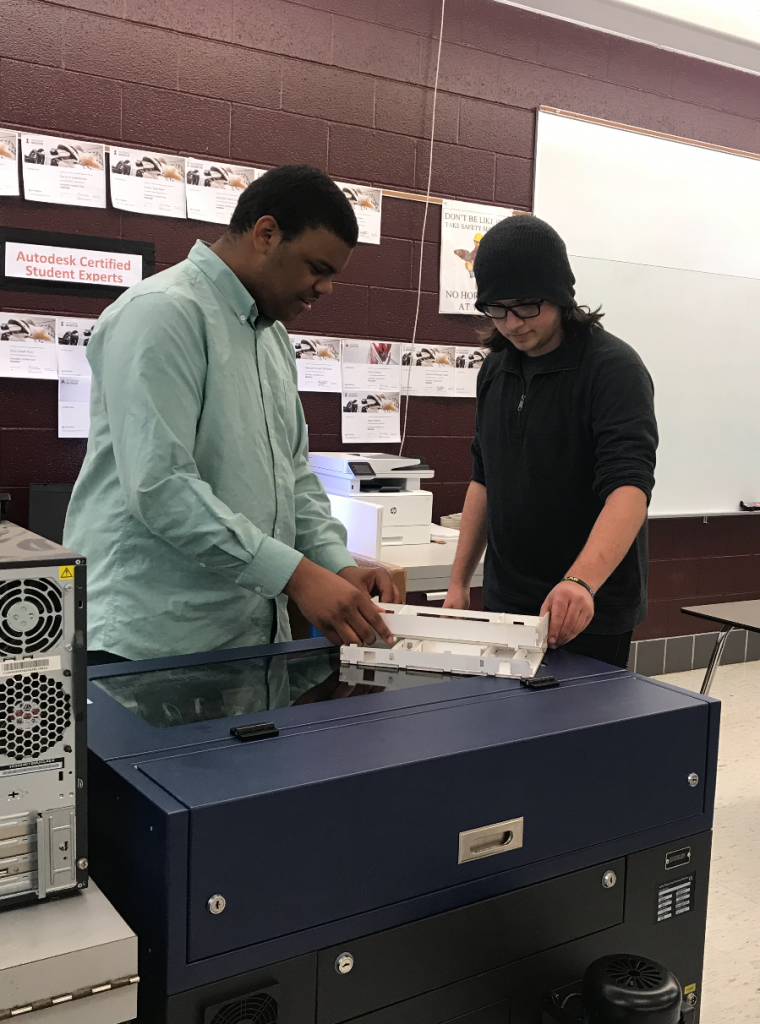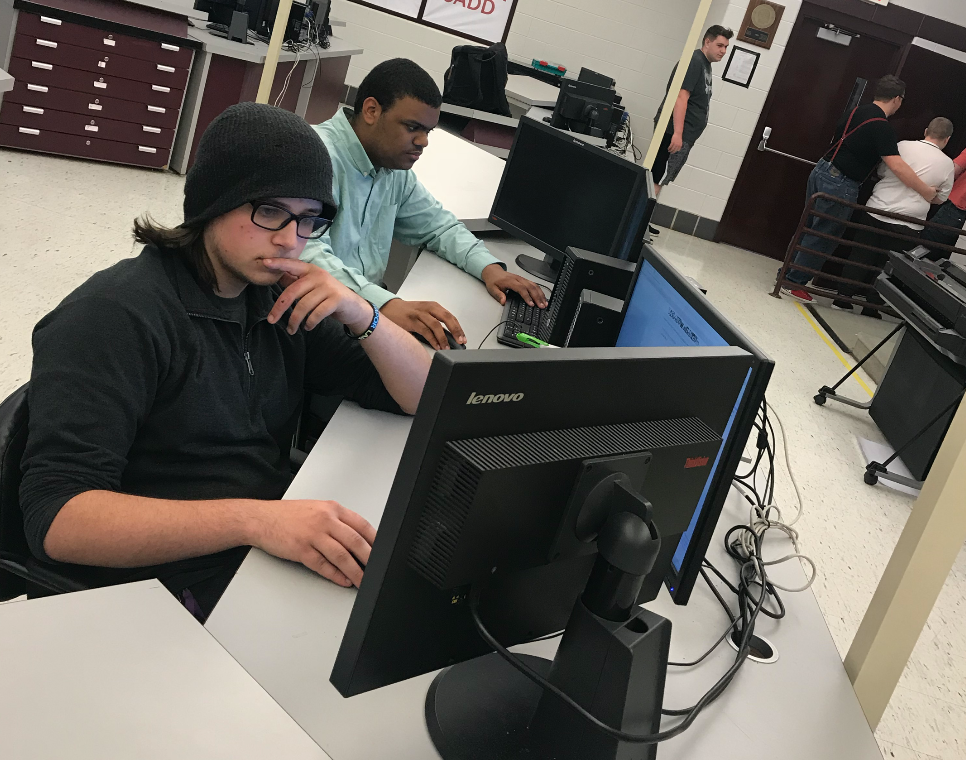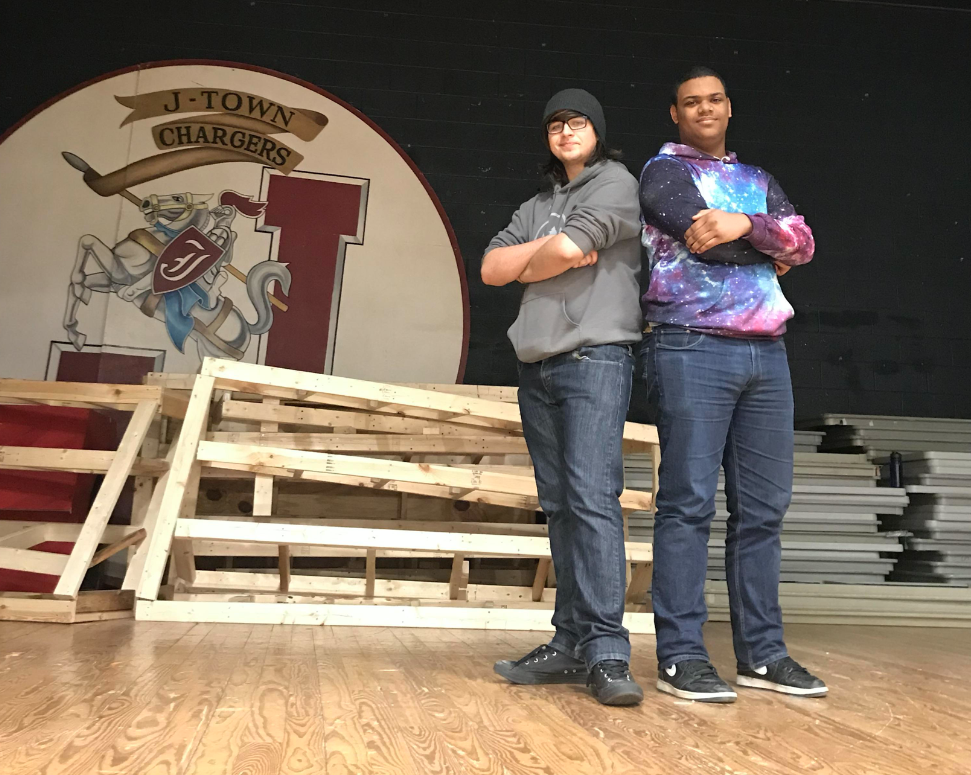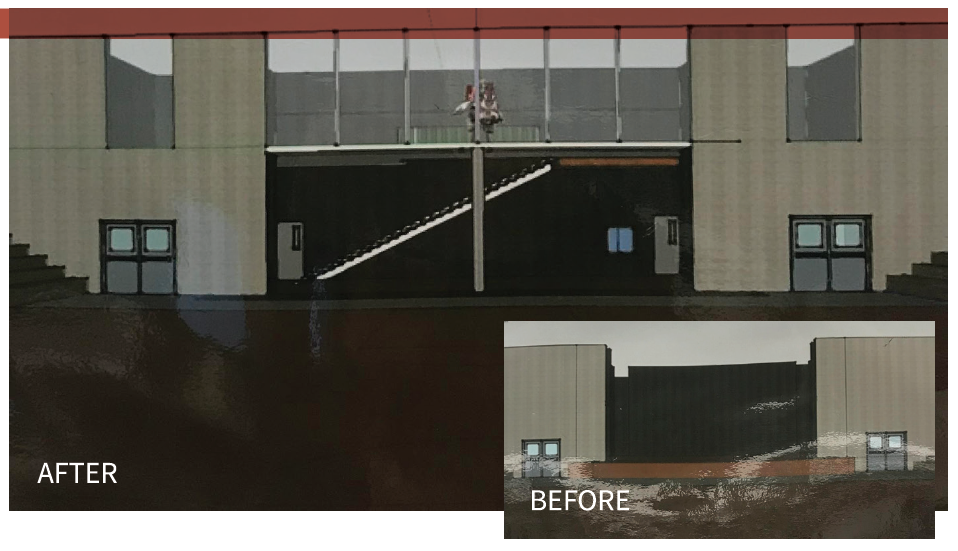Writer / Shannon Siders
Students in Jeffersontown High School’s Computer-Aided Design and Drafting program (CADD) are challenged to find innovative solutions to real-life challenges, and senior Adam Puckett and junior Reece Sistrunk have teamed up on a project that will benefit the JHS community for years to come.
The pair are heading up an entirely student-led project to transform the underutilized stage area in the school’s large gymnasium. In addition to being CADD students, Puckett and Sistrunk are part of the exclusive Architecture Construction Engineering (ACE) mentoring program that helps high school students discover career opportunities in the building design and construction industry while connecting them to professionals in those fields.
“This project started my sophomore year when the vice principal at the time came to the ACE program to ask us if we could take the stage area and allow it to be used for something else,” Puckett says. “The stage had not been used for over 15 years, and it was a wasted space. He wanted us to repurpose it and make it into something Jeffersontown could be proud of.”
With no further instruction from the school administration, the students began brainstorming options for the space. They finally settled on developing a two-level area with a mezzanine.
“We really tried to go for something modern and fresh looking, because Jeffersontown High School is getting a little older now,” Puckett says.
 The new design essentially doubles the amount of usable space in the area, providing an extra space for classes to use, plenty of storage space and a clear path to the concession stand during basketball games.
The new design essentially doubles the amount of usable space in the area, providing an extra space for classes to use, plenty of storage space and a clear path to the concession stand during basketball games.
“People were walking through the cheerleading area during games to reach the concession stand, and it became an issue,” Puckett says. “The concession stand idea came later, but was a deciding factor in what we were going to do. We wanted the concession stand to come into the gym, which opens up the whole mezzanine area to another space.”
Although the original group of students behind the project has fallen apart since the original brainstorming session, Puckett and Sistrunk have remained committed to the multi-year reconstruction.
“Usually in Ace we would just create something and then move onto the next project pretty quickly, Puckett says. “But when this came around, we really wanted to stick with it.”
After the initial idea came about, it took a few months for the students to build a model for their design. The students spent countless afternoons after school developing renderings for the space using the SketchUp computer program and even produced a 3D model to showcase their idea.
“We used AutoCAD and drew out the actual dimensions to make puzzle pieces that would snap in together using a laser cutter and foam board,” Sistrunk says.
Along with creating the design for the project, Puckett and Sistrunk also worked with their mentors through ACE to develop a feasible budget. With a budget in hand, they got to work raising money for the project, which will need just shy of $100,000 for completion.
The 3D model helped possible funders of the project get a better look at what the students had created and eventually resulted in a large donation from UAW-FORD and the leadership of UAW VP Jimmy Settles with the help of the Jeffersontown Alumni Association. JHS is sponsored by Ford, and representatives were impressed by the carefully designed and well thought out project.
The newly-designed space is just one of the benefits of the stage reconstruction for students.
“When the stage is taken out, the wood will be given to the art department and the metal and steel will be given to the welding department,” Puckett says.
Art students plan to make reclaimed sculptures out of the wood and also plan to honor those who donated to the project with an etching on one of the walls.
The metal frame underneath the stage that was used as a sliding chair holder is made out of mostly aluminum and steel and will allow students in the welding department to get a certification in aluminum welding.
“The welding teacher is certified in aluminum welding, and this will allow students to have something to practice on,” says Puckett, noting that high costs of metal have been a prohibiting factor for students seeking the resource in the past.
The project is slated for construction and should be completed sometime during the summer. After the project is complete, Puckett and Sistrunk both plan to continue using the skills they have learned in other projects, as well as their future careers.
Puckett, who graduates this spring, will continue a pharmaceutical software programming position in Seattle. He became hooked on the ACE program after being accepted his freshman year, even though he did not initially know what to expect.
“After my first year in ACE we made a hockey rink, and I really saw all the potential I could get out of this program,” he says. “We did 3D models for it, and I learned how an ice rink works and how there are 10 miles of cooling with frozen glycol tubes wrapped under the ice. Once I joined ACE, I knew it was something I was going to be involved with all four years.”
Sistrunk, who especially enjoyed the architecture and design portions of the project, learned a lot from an engineering standpoint, including how the mechanical side of a reconstruction project works taking into account HVAC, plumbing and other factors.
Jeffersontown is one of 11 high schools in JCPS participating in the Academies of Louisville, an educational experience that shifts from traditional techniques and environments to deeper learning and transition readiness for college, career and life. The stage reconstruction project has been a great example of what Jeffersontown is trying to achieve with its engineering and CADD programs.
Jason Stepp, CADD Instructor for JHS who is in his sixth year teaching at the school, is proud of what the students have accomplished and appreciates the opportunity it gave them.
“This is an ideal project for the students to put the knowledge they’ve learned in the classroom to a real-world application and get to see it become a reality,” Stepp says.
Puckett and Sistrunk are happy to have contributed to a project that will be enjoyed by the school community after their graduation.
“We wanted to build something Jeffersontown could be proud of,” Puckett adds. “Sometimes we get a bad reputation from other schools, but the engineering program here is amazing. We’ve learned a ton from it.”








